Members of ‘The Silk Alliance’ cross-supply chain industry partnership, initiated by the Lloyd’s Register (LR) Maritime Decarbonisation Hub, have issued an open letter to share their collective vision for the implementation of a green shipping corridor cluster, says an article published on Ir.
Outlines an implementation planLloyd’s Register
The open letter aims to increase transparency and accountability of the Green Corridor cluster initiative and outlines an implementation plan with key milestones and actions to achieve before the end of the decade, to steer members’ collective efforts towards accelerating zero-emissions shipping across the Indian and Pacific Oceans.
The multi-year implementation plan will focus on practical applications, exploring the deployment of vessels using near-zero-carbon ammonia and methanol fuels, scalable fuel supply infrastructure and avenues for bio and synthetic methane.
Short-term milestones
Implementation will commence by focussing on three short-term milestones. Initially, members will establish the sequence of the green corridor, including where the corridor will start and how it will scale over time. Then, by early 2025, Silk Alliance members will identify which fuel pathways to escalate from the initial pilot project stage by determining each fuel’s carbon intensity, and identify those pathways that will support the corridor with near-zero carbon fuels.
The third milestone will see a workstream focused on finance to address investment hurdles and identify financing mechanisms to get the initiative underway. The implementation plan outlines the key efforts needed to achieve the deployment of pilot vessels running on near-zero carbon fuels by 2027.
Green corridor cluster
By aggregating demand for alternative fuels through the pilot vessels running on low carbon methanol and High-Precision Tool Enhances Safety In U.S. Ports deployed in this initiative, Silk Alliance members will drive investments into scaled alternative fuel supply infrastructure in Singapore and the intra-Asia container trade route from 2028 to 2030. These fuels will have the scalability to further grow the wider regional bunkering market.
The milestones outlined in the open letter will need to be delivered through a combination of actions from Silk Alliance members alongside efforts from across the maritime value chain to support the ultimate implementation of this green corridor cluster. The implementation plan will be refined and updated by members as the initiative continues to progress.
The implementation plan
Charles Haskell, Programme Director, LR Maritime Decarbonisation Hub, said: “This open letter by members of the Silk Alliance demonstrates our strong commitment to ensure our learnings will be shared effectively as a model for cross-industry collaboration across the maritime supply chain, which is essential to accelerate decarbonisation goals. As we proceed with the implementation plan, we look forward to working closely with the Silk Alliance members in moving the green corridor cluster initiative from conceptual phase to action.”
Private sector engagements
Established by the LR Maritime Decarbonisation Hub, a joint initiative between Lloyd’s Register Group and Lloyd’s Register Foundation, members of the Silk Alliance comprise leading cross-supply chain maritime stakeholders.
Most recently, the membership expanded to include the Maritime Port Authority of Singapore and fuel producers, with the Alliance looking to continue strengthening its public and private sector engagements further.
Did you subscribe to our daily newsletter?
It’s Free! Click here to Subscribe
Source: lr


























